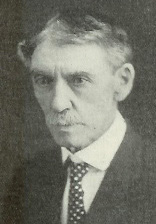When I first accepted the position as a student assistant at WKU Archives, I did not expect to go on such a fascinating historical journey. My experiences in the past year have been more invaluable than I ever could have imagined. Having the opportunity to work firsthand with the archived historical documents in WKU Archives has helped to paint a broader picture of the story as to how WKU began and what it has evolved into today. More specifically, my day-to-day tasks have mainly included collecting and scanning a multitude of different types of historical documents to be easily accessed on the TopSCHOLAR research & Creative Activity Database of WKU. The documents that I’ve been able to work on so far date back from the 1900s to the 1990s. The ability to upload these different materials from their physical form to our digital database has helped and will continue to help expose a vastly greater audience to the history of our school than ever before.
Continue readingCategory Archives: Uncategorized
Justin Harris: Student Worker Experience
Comments Off on Justin Harris: Student Worker Experience
Filed under Uncategorized
He Touched the Heart as Well as the Funny Bone
As we celebrate Black History Month, Library Special Collections would like to spotlight one of Bowling Green’s best known sons, Reuben Crowdus, aka Ernest Hogan. Coincidentally, local attorney and historian Ray Buckberry has recently donated a nice gift of research material about Hogan and sheet music written by him to Special Collections. Buckberry was the chief person responsible for researching and orchestrating the effort to get a historical marker erected for Hogan at the L&N Depot in 2009. Here we re-print a short biography of Hogan written by Buckberry for the publication Mt. Moriah Cemetery: A History and Census of Bowling Green, Kentucky’s African-American Cemetery (Landmark Association, 2002)

Reuben Crowdus was born 17 April 1865 in Bowling Green, Kentucky. Not much is known about his early life, although indications are that he left home at an early age, joining a traveling minstrel show. One of his first jobs is said to have been as a plantation singer in a low-rent, tent-show version of Uncle Tom’s Cabin, a show that launched the careers of many black entertainers.
In 1891, Crowdus adopted his stage name “Ernest Hogan” and later began referring to himself as “The Unbleached American,” utilizing both references throughout his career in show business. He wrote the lyrics, music, or both, for approximately 35 published songs. The 1896 sheet music for a song written by Hogan contained a notation that the music is to be performed “with Negro rag.” This was the first use of the word “rag” on a song sheet and many thereby credit Hogan as writer of the first piece of ragtime music.
His first big solo starring role in New York City came in 1898, with the show “Clorindy, or the Origin of the Cakewalk.” This was the first black show to play in a first class theater on Broadway. A Chicago paper reported that Hogan “is firmly established as the greatest colored comedian of the age.” The rising star organized a group of about 20 experienced entertainers in 1905, and called the “The Memphis Students.” Their opening show in New York was so successful it was held over for 5 months. This show has been referred to as the first public concert of syncopated music in history.
A long-cherished dream was realized when he mounted his own musical comedy “Rufus Rastus,” opening on Broadway in 1906. A critic commented that the depth Hogan brought to his new role took him out of the ranks of “darky comedian” forever in that he had learned to “touch the heart as well as the funnybone.”
Hogan became seriously ill and, in 1908, his business friends produced a benefit show in his honor. The show lasted four hours and a noted black performer remembered it as the “greatest assembly of colored actors ever to appear in the same theater and on the same stage in one night.”
On 20 May 1909, Hogan died. His remains were returned to Bowling Green for burial in Mt. Moriah Cemetery. By Hogan’s request, the local band participating in the service at the Methodist Episcopal Church, played only his favorite ragtime tunes. At the cemetery, the many floral displays were said to represent the most flowers ever received for any funeral in Bowling Green.
Hogan had an infectious and crusading spirit, talent and generosity; he was appropriately referred to as “a Moses of the colored theatrical profession.”
To see the finding aid for the Ernest Hogan research material, click here. To see other material in our collections about Hogan, search KenCat or TopSCHOLAR.
Comments Off on He Touched the Heart as Well as the Funny Bone
Filed under Manuscripts & Folklife Archives, Uncategorized
Kentucky Club Woman, Official Organ of the State Federation of Colored Women’s Club
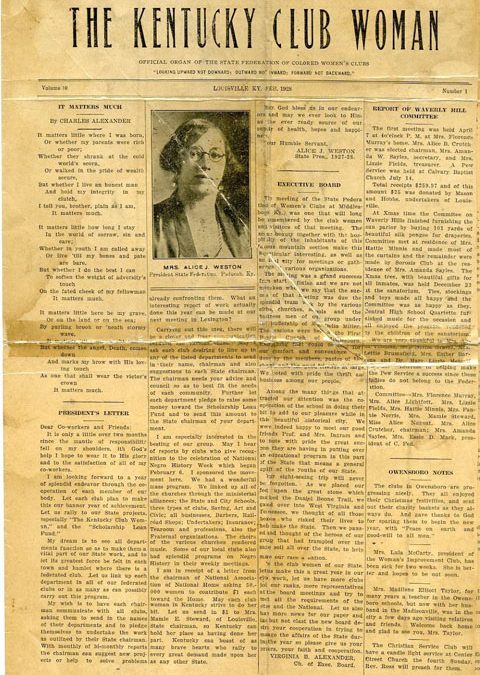
This rare newsletter, The Kentucky Club Woman: Official Organ of the State Federation of Colored Women’s Clubs is representative of the collection focus of Special Collections Library. We hold materials that are either irreplaceable or unusually rare and valuable. We also maintain items in a secure location with environmental controls to preserve the items for posterity. This newsletter was produced by the Kentucky State Association of Colored Women’s Clubs which was organized in 1903. They boasted a membership of 2,500 women in 112 clubs. The Kentucky clubs specialized in “fostering day nurseries, hospitals, old folks homes; homes for delinquent girls, building club houses and community centers.” We are the only holding library for this issue. Find this and other one-of-a-kind items by using the One Search box, TopScholar and KenCat.
Comments Off on Kentucky Club Woman, Official Organ of the State Federation of Colored Women’s Club
Filed under Uncategorized
Food, Glorious Food!
Food is one of the necessities of life. It is no surprise that Library Special Collections—which documents the Commonwealth’s culture—has quite a few items related to food. To celebrate this culinary material, an exhibit titled “Food, Glorious Food!” has been installed in the Jackson Gallery, on the second floor of the Kentucky Building. The exhibit will run through June 26.
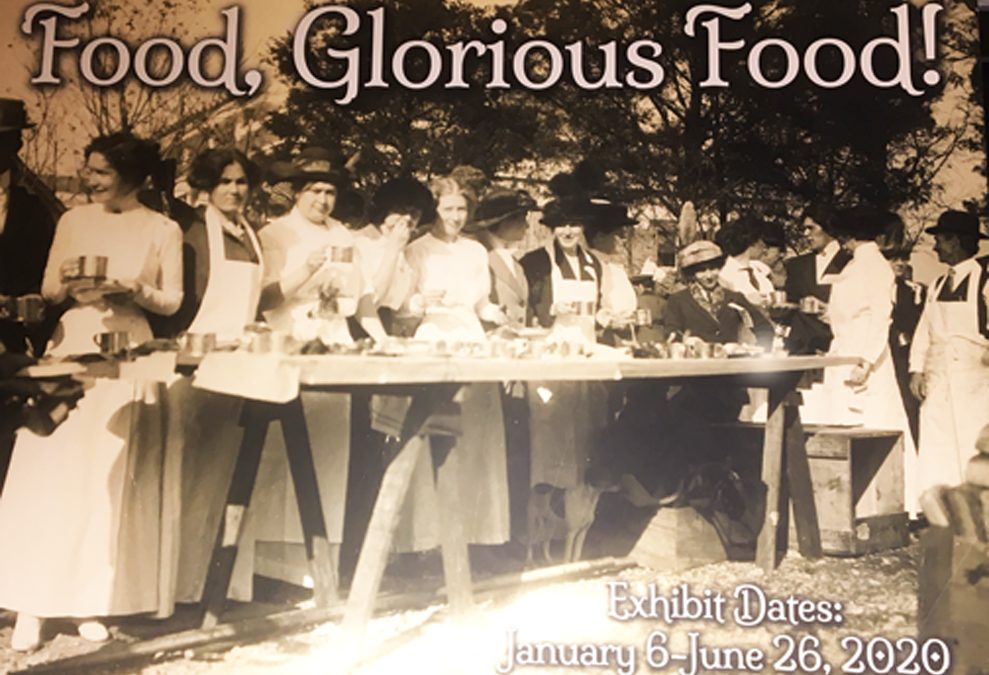
Each case within the exhibit represents different aspects of Kentucky’s culinary heritage. Chief amongst the cases is one that highlights the collection’s cookbooks. In 2003 the Kentucky Library was the beneficiary of a large number of cookbooks from the estate of Jeanne (Leach) Moore, a Morgantown native. This collection included over 1,500 titles that were added to the collection. This was expanded significantly with a gift from Albert Schmid a few years later. Without a doubt, Library Special Collections boasts one of Kentucky’s most significant cookbook collections. This case features the variety of cookbooks found in the collection ranging from an 1823 early-American cookbook to children’s guides to cookery. Because of the depth of this collection, cookbooks are used throughout the exhibit.
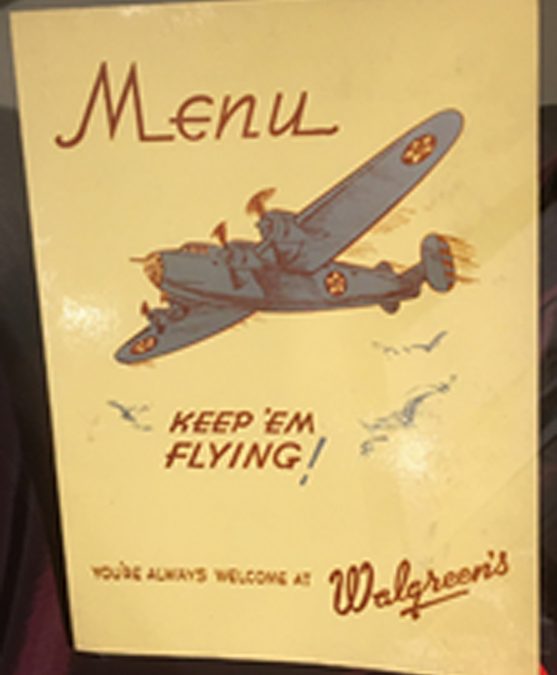
Another focal case features menus from restaurants across the state, ranging from dime store soda fountain menus to those from fine Louisville restaurants. These items are cultural treasures, as they share fares available at various food establishments, costs of items, logos and trademarks, and colorful graphics. This case also includes examples of matchbooks, once a ubiquitous give-away at restaurants, postcards, and business cards.
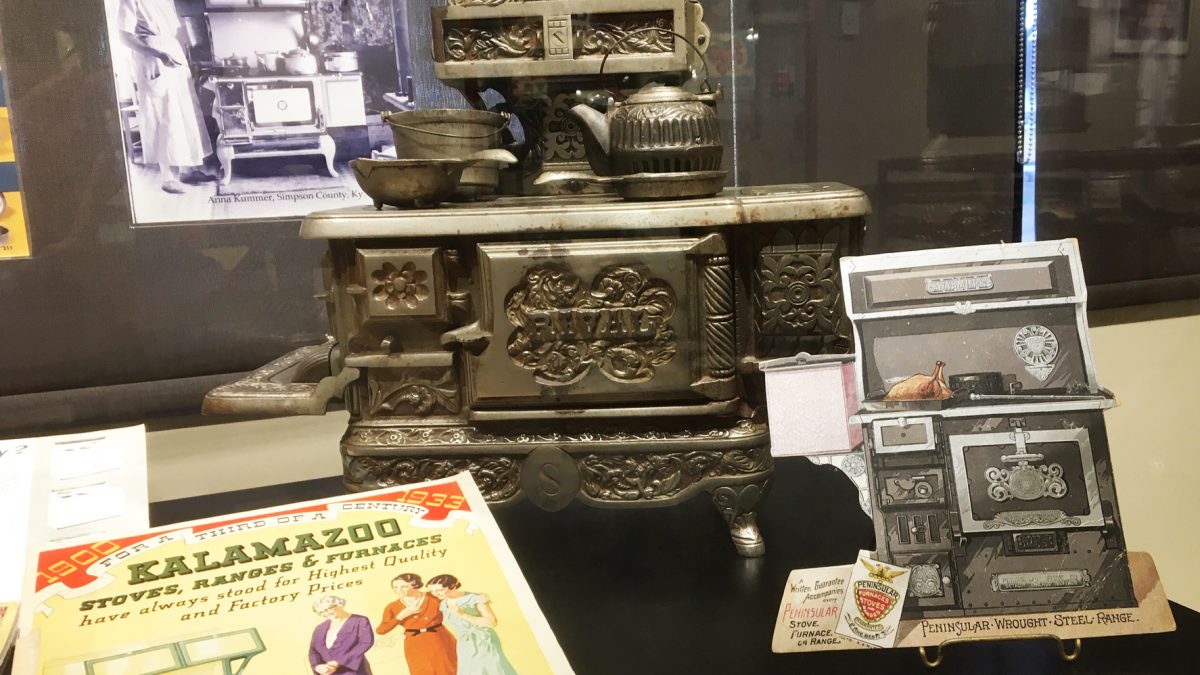
One case includes material related to stoves and ranges. Generally a stove uses coal or wood for a fire source, and a range uses electricity or gas. This case features cookbooks from several appliance companies, photographs of these appliances, and promotional material issued by various manufacturers. Included is a photograph of the showroom of the Louisville Tin & Stove Company which shows many of the company’s wares on display. Also included is a catalog from the same company which indicates the great array of stoves and other items produced by this concern. The last two items were donated by Pam Elrod. The highlight of this case is a miniature toy stove donated by Marjorie Claggett and appears courtesy of the Kentucky Museum.
Other cases feature images and publications from Western Kentucky University food science classes and other campus food related activities; labels and other items of food packaging; material highlighting some Kentucky food specialties such as cream candy, Hot Browns, derby pie, and mint juleps; and large posters and photographs that document certain aspects of food in the Commonwealth.
Comments Off on Food, Glorious Food!
Filed under Manuscripts & Folklife Archives, New Stuff, Uncategorized, University Archives
Tobacco Warehouse
A rare and apparently unrecorded broadside, recently acquired by the Department of Library Special Collections, describes a public meeting in Hickman, Kentucky. From this meeting, a committee of five men were appointed to approach the Kentucky legislature about the creation of a state tobacco warehouse. They wanted to “memorialize” or remind the Legislature of the heavy charges which are imposed at New Orleans and present Hickman, KY as an alternative. Hickman, they note is a desirable location that is easily navigable all year round. They record that Hickman’s shipments for the year, 1846 are: 3000 hogshead of tobacco, almost 20,000 bushels of wheat and 1350 bales of cotton. Senator Thomas James presented to the Kentucky Senate this memorial for the people of Hickman and Fulton County. Hickman, the county seat of Fulton County, is situated on the Mississippi River in western Kentucky’s Jackson Purchase region. There is no evidence, in later Senate journals that the Legislature chose Hickman as a state shipping center. However, tobacco, cotton, timber, and other products were shipped both by rail and by steamboat from Hickman and it gained increasing prominence as a transportation center.
See this and other broadsides at kencat.wku.edu
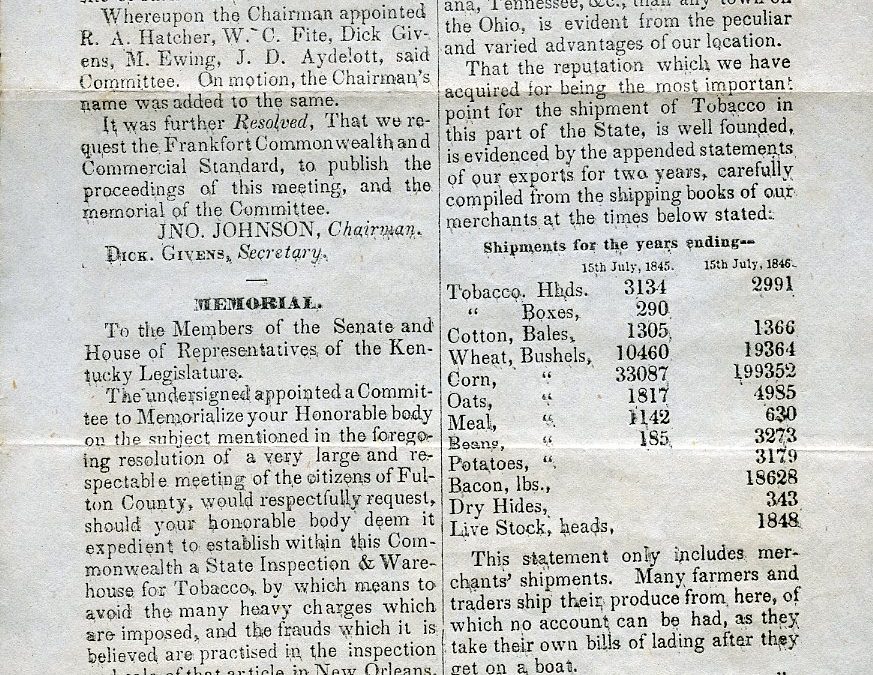
Comments Off on Tobacco Warehouse
Filed under Uncategorized
Nothing New Under the Sun
A recent acquisition for the Department of Special Collections highlights the American or Know-Nothing Party of Kentucky. The flier offers notice to the Subordinate Councils of Kentucky as they clearly state the organization’s purpose. It was, in part, to “put down all foreign influence in the country – to alter or repeal the naturalization laws – to put down the designs of the Romish church – in short, we want an American Party.” The party hoped to “thoroughly Americanize your neighborhoods. As they [resolved] “that Americans shall rule America.” One result of the philosophy showcased in the flier was “Bloody Monday.” This event occurred on August 6, 1855, an election day, when German and Irish Catholic neighborhoods were attacked.
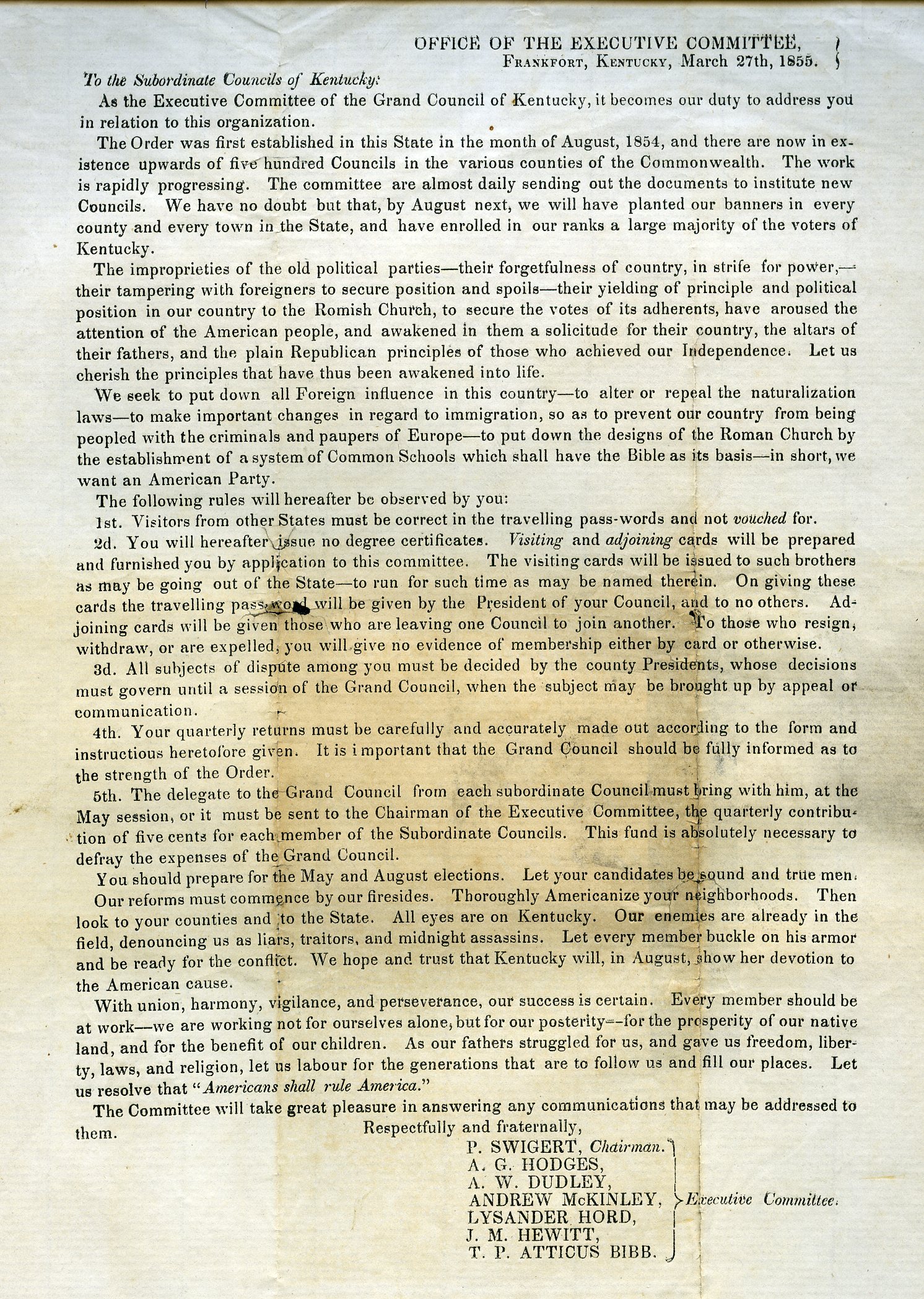
See this and other fascinating fliers, broadsides and other illustrative materials at TopScholar and KenCat. Email spcol@wku.edu for further information or assistance.
Comments Off on Nothing New Under the Sun
Filed under Uncategorized
Hotel Register Provides Material for Classroom Assignment
Dr. Walker Rutledge, WKU Professor of English, annually brings his English 300 class to the Kentucky Building for an introduction to manuscript collections held by Library Special Collections. Afterwards, the students select a collection to read and then write a summary related to it. The following is Cameron Fontes’ paper. He chose to write about the Mansard Hotel register from the collection (SC 1236). To see the finding aid for this collection click here.
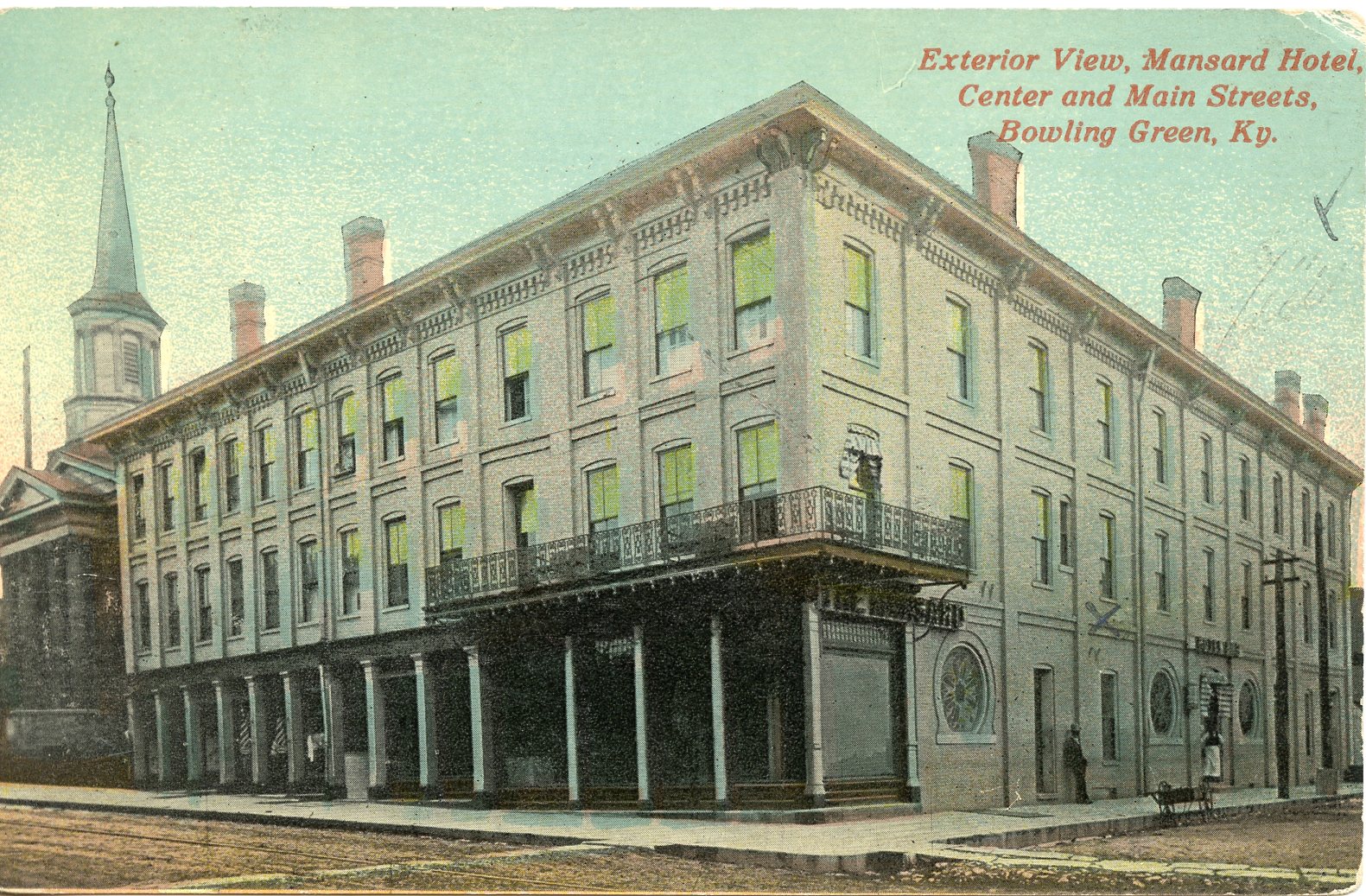
Unlike the many impersonal, chain-owned hotels of today, the Mansard Hotel in Bowling Green, KY, encapsulated all the best parts of its community. It was a locally-owned, well-kept institution where local leaders and travelers alike commingled amidst luxurious, yet affordable, furnishings and convenient eateries. When guests arrived at The Mansard, either for just a meal or for an overnight stay, they recorded the details of their visit on the tall, lined pages of the hotel register in grand, gorgeous script. Although it is now yellowed and musty with age, he Mansard Hotel register kept from 16 August 1907 to 7 October 1907, provides an intimate and detailed portrait of the bustling environment of a small-town hotel in the first decade of the twentieth century.
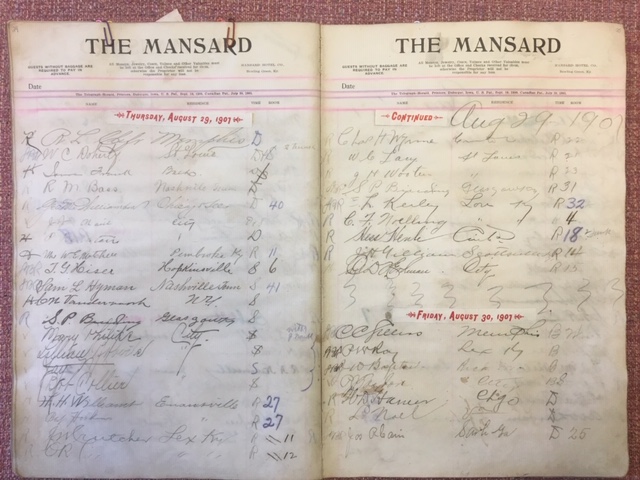
Located behind what was then the local opera house, the Mansard stood near the corner of Main and Center Streets in downtown Bowling Green. At check-in, one of the register columns guests were required to fill out if they were staying overnight was the “Room” column, in which they were to write their room number as well as the number of pieces of luggage they brought with them. Although the number of pieces each guest brought with them is nothing especially noteworthy, one interesting observation that can be made upon reading the record of each guest’s luggage is that for the most part, guests only used trunks rather than suitcases, which are probably the most common type of luggage in use today. On 7 September 1907, a guest who signed as “E. Jenkins” from Buffalo, New York, brought with them one trunk and stayed in room seven.
Buffalo was only one of a plethora of places from which guests at the Mansard traveled. Each guest wrote their place of origin in the register column marked “Residence,” their responses ranging from various towns within Kentucky, such as Golden Pond and Louisville, to St. Louis, Missouri, Evansville, Indiana, and many cities besides. If a guest were visiting simply to take in a meal at the hotel restaurant, they wrote “City” to indicate that they were a resident of Bowling Green. One especially fascinating entry in this column on 24 September 1907, is that of Ed H. Foster, who signed that he was from “Coffeetown,” a small town in Pennsylvania located, funnily enough, about five miles from the town of Hershey.
It is evident which guests in the register were only visiting for a meal by whether or not they write a room number in the “Room” column next to their response in the “Time” column. Obviously, if there was a room number in this column, that was the room in which the guest who signed on that line stayed. If there was no room number, however, one has only to look at the guest’s response in the “Time” column to see for which meal they made a trip to the Mansard. Each guest signed either a “B,” “D,” “S,” or “R”. Most likely, the first three letters indicated the meal at which each guest dined or the closest meal to which each guest checked in for their stay, “B” being for “Breakfast,” “D” for “Dinner,” and “S” for “Supper.” “R” would likely have stood for “Resident,” seeing as how the demographic of permanent residents of hotels was much more common in 1907 than today.
One very famous Bowling Green resident who visited the Mansard for breakfast om 2 September 1907, was none other than Henry Hardin Cherry. Western Kentucky University’s first president, Cherry signed his name in big, beautiful cursive along with the name of his beloved hometown, making sure to proudly write out “Bowling Green, KY,” instead of simply “City,” as so many others had done. That he would have been well-respected and well-known at the time is likely. Having just become the president of what was then “Western Kentucky State Normal School” the year before, he would have already been considered a bastion of higher education in the community.
Other notable guests at the Mansard during this time included C.W. McElroy, a state representative for Bowling Green, on 21 August 1907, for supper, along with a couple of other individuals with prominent Bowling Green names including R.B. Potter from Woodburn, Kentucky, on 9 September 1907, and N.J.M McCormick from Indianapolis, Indiana, on 10 September 1907, who may have both been in town visiting family.
Sadly, the Mansard Hotel burned down on 5 July 1969. To stay in a hotel as charming as the Mansard may seem impossible today, but by perusing its old register one can start to gain a sense of its local charm and grandeur. cked
Comments Off on Hotel Register Provides Material for Classroom Assignment
Filed under Manuscripts & Folklife Archives, Uncategorized
New Broadside Acquisition for Special Collections
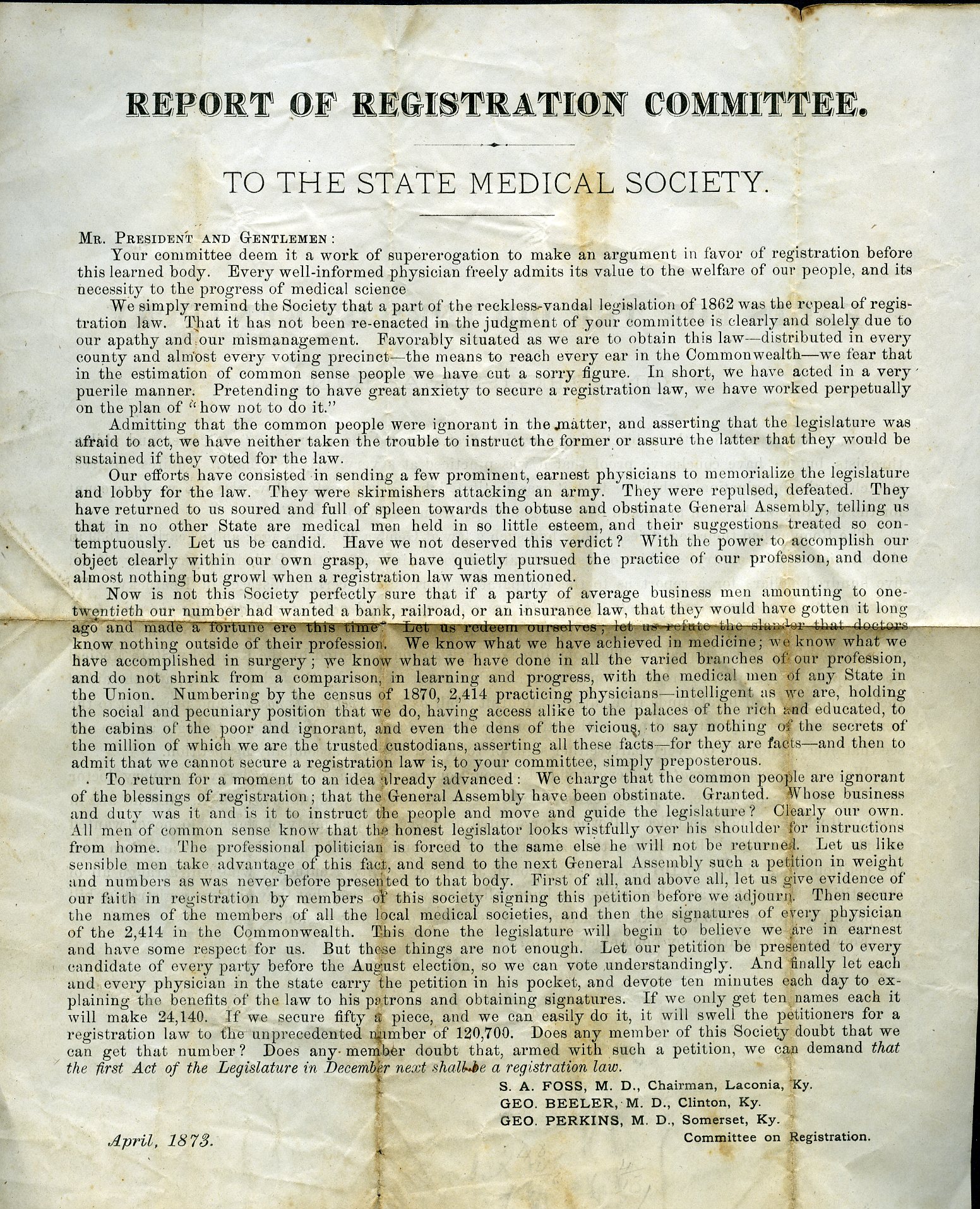
Just like a difficult birth, Kentucky faced painful hurdles in enacting a law for the registration of vital statistics. The value of recording such facts was noted as early as 1821 by Kentucky’s General Assembly which required registration for all children between the ages of four and eighteen. This occurred 15 years earlier than the civil inauguration in England. It was not until 1852, however that the state passed a law for all births, deaths and marriages and the production of an annual statistical report. In 1859, the Office of Registrar of Vital Statistics was also created. But, with the advent of the Civil War, all registration efforts ceased until 1873. A recently acquired broadside for Library Special Collections, highlights Kentucky physicians’ call for vital statistics registration. The flyer is addressed to the State Medical Society offering an argument in favor of starting this important task again. The report of the Registration Committee to the State Medical Society is laced with clear judgments on the apathy of the profession and the “reckless-vandal legislation of 1862” which repealed the law. The committee notes that most doctors have “acted in a very puerile manner,” and “have worked perpetually on the plan of ‘how not to do it’!”
A political climate, very familiar to us today is showcased by certain physicians who tried to deal with the government, but returned, “soured and full of spleen toward the obtuse and obstinate General Assembly.” The doctors also condemned themselves for their low-key approach to the problem noting it was but a growling effort not worthy of such a cause.
The flyer calls for renewed efforts by the 2,414 practicing physicians “whose business and duty [is] it to instruct the people and move and guide the legislature.” A call was issued for the physicians to grab every signature of “all who are in office, all who have been in office; all who ever wanted an office and as many of those who never wanted an office as you can get.”! In essence, every person in the state should be approached. Why God himself must have approved of such labors, as it is noted that “an unbroken chain of genealogy [existed] from Adam to Christ.” A little hyperbole in the flyer went a long way and proved successful as the law was passed. Sadly, however, no central office was created to enforce, safeguard or compile the statistics.
It would not be until 1910, when the State Board of Health was successful in passing the present law that vital statistics registration was successfully implemented. Birth and death registration was enacted statewide on 1 January 1911, and mostly adhered to by 1920. The blank death certificate shows how valuable the information obtained can be for many types of research.
The Baird Fund, established by former DLSC faculty member Nancy Disher Baird, funded acquisition of this document. “The Baird Fund has been an invaluable tool in helping us grow the collection,” said Jonathan Jeffrey, DLSC Department Head. “We appreciate Nancy’s generosity and her foresight.”
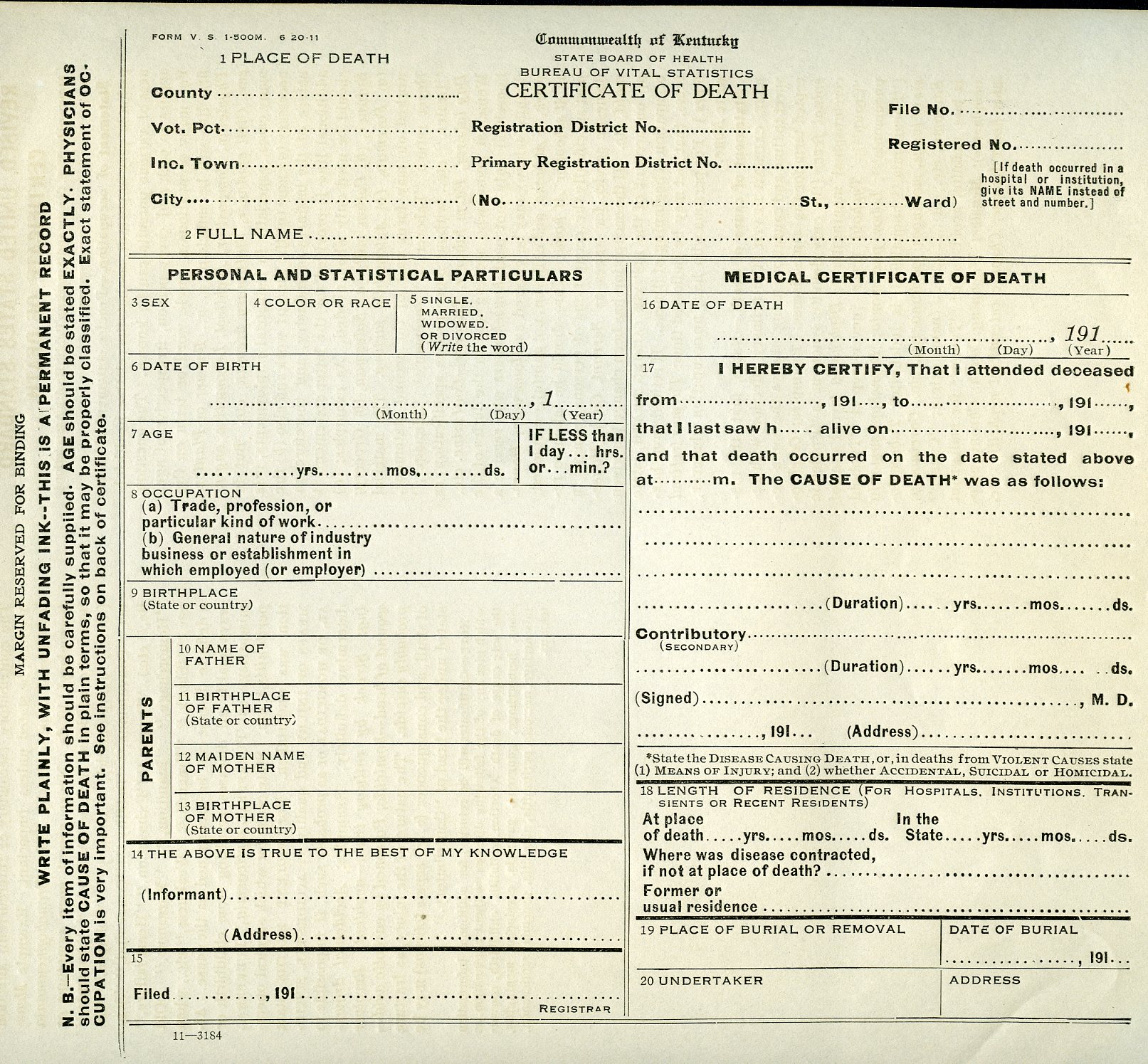
See this wonderful flyer and other materials related to medical history in our holdings, visit TopSCHOLAR or browse through KenCat, our searchable database featuring manuscripts, photographs, and other non-book objects housed in the Department of Library Special Collections.
Comments Off on New Broadside Acquisition for Special Collections
Filed under Uncategorized
Paradise

In 1957 Sid & Florence Jobs wrote a prospective visitor to their Camp Paradise on Kentucky Lake that he should call long distance and make reservations, because their eight cottages were in high demand. They told the potential guest that his boxer dog was welcome “if there is no danger of him with the children on the premises.” The Jobs also send along a promotional postcard and literature along with several photographs as a way to tempt this vacationer to the place they considered Paradise, three miles from the nearest store or restaurant in Calloway County.

Camp Paradise, created in 1944 and nestled next to Kentucky Lake, stayed open for business from April 1st to December 1st each year. It lured some families for lake vacations, but its chief attraction was fishing on Kentucky Lake’s 160,000 acres. Promotional literature explained: “Day-in and day-out fishing in Kentucky Lake is considered the best among the manmade lakes in this part of the country by many fishermen…Almost all species of fresh water game and rough fish are represented here. Just to mention a few among the game fish are Crappie, Large Mount Bass, Small Mouth Bass, Striped Bass, Walleye Pike, Channel Cat, and Blue Gill. You can cast, troll, or stillfish anytime during our 12 month season and be reasonably sure of catching some of these fish.”
By way of accommodations, the Jobs could offer five one-bedroom cottages and three two-bedroom cottages, which were frame buildings clad in shingle tile siding and constructed on cinderblock foundations. The interiors boasted knotty pine paneling, celotex block ceilings and tile floors. Amenities included: tile showers, modern kitchens equipped with refrigerator and gas range, cookware, china, cutlery, linens, electric heating, hot water, and fans. Towels were not included. Guests were encourage to bring any necessary electrical appliances “to make your stay more enjoyable.” Every cottage had an outdoor barbecue pit, picnic table and lawn chairs. The one-bedroom cottages rented for $6 per night or $36 for a week and two-bedrooms rented for $9 per night or $54 per week. At the camp’s dock you could rent a boat for $2 per day or $12 a week, but you had to pay $4 extra per day for a 5 horsepower motor to go with it. Life preservers were thrown in free of charge.
Fishing, swimming, boating and hiking were encouraged in this isolated spot on Kentucky Lake. The Jobs assured their guests: “We will try to make your stay most enjoyable.”

The information for this blog post was culled from a small collection of items recently acquired by the Manuscripts unit of Library Special Collections. We were excited to learn the camp still exists but is known today as America’s Paradise Resort boasting eleven cottages, five condominiums and a full-scale marina. Modern owners still consider this Paradise. Their website encourages guests to “relax and take in the amazing sunsets for the family and discover why so many refer to our resorts as a ‘little slice of heaven.’” To see the finding aid to our small collection, click here.
Comments Off on Paradise
Filed under Manuscripts & Folklife Archives, Uncategorized
New Year’s Away From Home
Where did you spend New Year’s Day? On January 1, 1909, Bowling Green attorney Clarence Underwood McElroy found himself amongst other invited guests at the royal palace in Manilla, Philippines. Governor-General James Francis Smith invited McElroy, who was on an extended trip to the Orient, to the “national holiday” soiree. McElroy recorded the temperature at 89 degrees and noted that the “grounds men elaborately decorated [the courtyard] with Japanese lanterns and electric lights in the fountain.” He goes on: “The Palace is designed for entertaining and was built by the Spanish and was occupied by the Spanish Governor-General. The rooms are very large with beautiful mahogany hardwood floors of planks from 12 to 15 inches wide. The Palace is right on the river bank and boats come up to the porch. The reception was largely attended. All the elite being out in force…American, English, Spanish and Filipino.”
Governor-General Smith had served with Theodore Roosevelt’s Rough Riders during the Spanish-American War and was part of the first expeditionary force to the Philippines during that same conflict. He later served as an associate justice on the Supreme Court of the Philippines and subsequently on the Taft Commission which was responsible for developing a legal code for the Philippines. William Howard Taft appointed him as Governor-General in 1906, and he served in that capacity until 1909. During this period the Philippine Assembly convened for the first time.
Clarence McElroy, one of the most revered members of the Bowling Green bar, kept a detailed account of his trip to the Orient. On this trip he visited the Sandwich Islands (Hawaii), Japan, Hong Kong, China, Ceylon and the Philippines, and he jotted down copious notes about the industrial, economic, and cultural aspects of each country. To learn more about his journal, click here. In addition to these travel journals, Library Special Collections houses over 50 boxes of correspondence and case files related to McElroy; to view the finding aid for this collection click here. A portion of McElroy’s diary is included in an online exhibit titled “Seven Continents” which features travel items found in Library Special Collections.
Comments Off on New Year’s Away From Home
Filed under Manuscripts & Folklife Archives, Uncategorized


